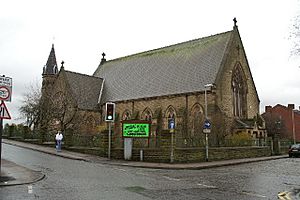Ince-in-Makerfield facts for kids
Quick facts for kids Ince-in-Makerfield |
|
|---|---|
 Christ Church, Ince-in-Makerfield |
|
| Population | 15,664 (2011 Census) |
| OS grid reference | SD565005 |
| Metropolitan borough |
|
| Metropolitan county | |
| Region | |
| Country | England |
| Sovereign state | United Kingdom |
| Post town | WIGAN |
| Postcode district | WN1–WN3 |
| Dialling code | 01942 |
| Police | Greater Manchester |
| Fire | Greater Manchester |
| Ambulance | North West |
| EU Parliament | North West England |
| UK Parliament |
|
Ince-in-Makerfield, often called Ince, is a town in Greater Manchester, England. It is part of the Metropolitan Borough of Wigan. In 2011, about 15,664 people lived there.
Ince is very close to the larger town of Wigan. It used to be part of the historic county of Lancashire. A railway line divides Ince into two main areas: Higher Ince and Lower Ince. From 1894, Ince was an urban district. In 1974, it became part of the Metropolitan Borough of Wigan.
Contents
What's in a Name?
The name Ince might come from an old language called Cumbric. In this language, ïnïs means 'island'. Here, it probably means 'dry land'. This is similar to the Welsh word ynys.
A Look Back in Time
The first mention of Ince as a manor (a large estate) was in 1202. It was owned by the Ince family. They also owned land in Aspull. Over time, the Gerard family took over the manor. They kept it for many centuries. Later, William Gerard sold it to the Earl of Balcarres.
There were once four important houses, or "halls," in Ince. The original Ince Hall was made of timber. Another hall, New Hall, was home to a branch of the Gerard family. The third, also called Ince Hall, was built around the time of King James I. It had a moat and fancy chimneys. Sadly, a fire damaged it in 1854. It was rebuilt with plain bricks. None of these old halls are still standing today.
Ince-in-Makerfield also has a Town Hall. It was finished in 1903.
The area of Ince covered about 2,221 acres. Under the ground, there was a lot of coal. Many coal mines were dug here. Some pits were very deep, up to 1,800 feet! Famous coal mines included Moss and Rose Bridge. Mining left behind large piles of waste rock and water-filled holes called flashes.
Stone was also dug up and used to build railway bridges. Ince became very industrial during the Industrial Revolution. The Leeds and Liverpool Canal and several railway lines passed through the town. A cotton mill was also built.
Getting Around Ince
Ince has its own train station, called Ince railway station. It is on the line that goes from Manchester to Southport. To avoid confusion with another place called Ince, the station signs often say Ince(Manchester).
In the past, many railway lines crossed through Ince. These lines connected Ince to places like Wigan, St Helens, and Liverpool. There were also smaller lines that went to the coal mines.
The Leeds and Liverpool Canal also runs through Higher Ince. Sixteen of the famous Wigan flight of locks are located within the town.
Local Industries
Ince used to have a factory that built and repaired railway wagons. It opened in the 1870s. It was first called Richard & John Olive. Later, it became the Ince Waggon & Iron Works Co. In 1933, it became part of the Central Wagon Company.
As fewer new wagons were needed in the 1960s, the company started to scrap old railway stock. This included wagons, carriages, and even steam locomotives. They cut up over 300 British Railways steam locomotives in the mid to late 1960s. The factory closed in 1980.
Images for kids
See also
 In Spanish: Ince-in-Makerfield para niños
In Spanish: Ince-in-Makerfield para niños





